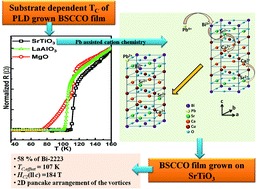Effects of Pb assisted cation chemistry on the superconductivity of BSCCO thin films
Abstract
Thin films of Bi-based superconductors, highly c-axis oriented, were deposited on single crystalline substrates of SrTiO3, LaAlO3, and MgO using a pulsed laser deposition technique with a Bi-2223 target of nominal composition Bi1.75Pb0.25Sr2Ca2Cu3O10±δ prepared by the solid state reaction method. The effect of different deposition parameters on the evolution of the requisite properties in the thin films has been studied. These films have been characterized by X-ray diffraction to investigate their structural properties, scanning electron microscopy to understand the effect of ex situ annealing on the grain growth, and DC resistivity measurements to quantify their superconducting critical temperature. Furthermore, the chemical states of the constituent elements Bi, Pb, Sr, Ca, Cu and O were confirmed using X-ray photoelectron spectroscopy. This information has helped in deciphering the empirical stoichiometry of the films on each of the chosen substrates. We have also been able to comment on the influence made by the choice of the substrates on the mechanism of evolution of superconductivity based on the interplay of the cation chemistry between the substituent and the constituent elements. Thin films with superior superconducting properties were obtained on SrTiO3 substrates with 58% of Bi-2223 phase fraction yielding a superconducting transition temperature (TC,offset) of 107 K. Magnetotransport studies were performed on these films to quantify their superconducting upper critical field and to comprehend the pinning mechanism.



 Please wait while we load your content...
Please wait while we load your content...